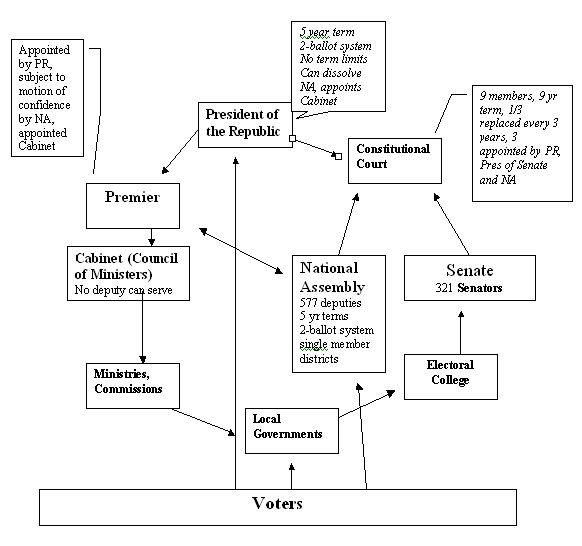PLS 131 - French Politics
I. Basic themes found in discussions of French politics
a. Revolutionary break with traditional society
b. History of regime
changes
c. Broad ideological spectrum
d. Strong state role – early bureaucracy, late state
planning
d. Geographic insertion at the heart of Europe
II. Identity crisis overcome
a. Existence of France
as separate kingdom dates to 987 – ascension of Hugh Capet as King
1. Through next few centuries – revival of commerce, Paris (Sorbonne) as center of theological learning, strong French role in Crusades (13th C)
2. Early royal administration (civil service/judicial system) established and reinforced (13-14th C) (early state penetration of society)
3.
15th C – lots of instability, revolts – Burgundy allied with English
results in English rule, with Joan of Arc helping to defeat them along with
Burgundy changing sides – by 1453 English ousted.
4. 16th C – period of numerous wars esp. vs.
Hapsburgs.
a. Religious warfare due to spread of Reformation – curbed by Edict of Nantes (1598) (later revoked)
5. 17th C – further consolidation of royal,
central power and military projection outwards under Louis XIV
|
a. Versailles established b. State debt increased c. Rest of Europe unites against France – wars deplete France
|
|
6. 18th C – Feudal residues remain –
a. Privileges for families, guilds, monopolies, clergy, nobles
1. “Parlements” were aristocratic organizations opposed to further centralization and royal taxes
b. Commerce impeded by monopolies and internal tariffs
c.
Large rural population becomes
a drain on Fr. Economy
7. French Revolution –
1789
a. Initially based on royal need to call in States-General – which were to pass on any new taxes
b. “National Assembly” formed
i. Constitutional Monarchy (1791)
ii. Radicalization (1792-94) – Reign of Terror, beheading of king and queen
iii. Directory – replaces radicals
iv.
Napoleon Bonaparte – coup, then
emperor (1804-14)
III. Legitimacy Crisis – a residue of
French Revolution, Bonapartism
a. Constant theme – Popular explosions, centralized rule, autocratic tendencies, counter-autocratic responses, popular explosions
b.
Other residues of Napoleonic period involving
"penetration" and "participation":
a.
Napoleonic Code of law
b. Central administration of provinces – prefects
c.
Relative state autonomy from societal pressures (in
short run)
d. Emergence of democratic ideals
i.
Equality of citizenship
ii.
Participation in
governance
iii.
Nationalism
iv.
Individualism
c.
Legitimacy Crises expressed in great variety of regime
types:

d. Legitimacy crisis - critical moments:
i.
Paris Commune (1870-71)
ii.
Popular Front Government
(1936-8)
iii.
Loss to Germany (WWII) –
Vichy regime
1. Collaboration of French with Nazis
iv.
Algeria crisis (1958) –
near coup installs Charles DeGaulle
v.
May 1968 –
student-worker revolts
vi. 1981 – election of Socialist President F. Mitterand
Participation: Expansion of Electorate in Europe (see
chart)
e. Participation crisis and legitimacy of representative
institutions only partially signaled by expansion of franchise
1. Great expansion of suffrage in 1848 – for election of
Louis Napoleon Bonaparte President of Second Republic
2. 1852 – proclaims himself Emperor (Second Empire)
3. Third Republic/Republican constitution adopted, but franchise stays at around 45%
4. WWI – expansion of franchise to 75% in 1916
5. WWII – expansion of franchise to nearly 100% in 1946
IV. Penetration Crisis - State building and economic development
a. Industrialization
1. French economic importance based mostly on sheer size rather than able and early industrialization
2. Retardants to industrialization
a. Large peasantry – consolidated by the French Revolution
b. Lack of some key raw materials such as coal, iron, petroleum
c. Large urban petty bourgeoisie – small family owned businesses, lots of artisans, administrators, etc.
d. Weak entrepreneurial spirit
e. Production for local markets, luxury markets
f. Protectionist policies by the state
i. But state did rationalize railways
g. Weak population growth
3.
Social effects
a.
slow displacement of population
from agriculture, rural areas to industrial urban centers – relatively small
industrial working class
b. Rather than feudal aristocracy becoming large
industrialists, French Revolution creates society without much private industrial leadership
4.
Relatively weak military –
lacks industrial capacity to compete with Germany, Britain and US
b. After WWII
1. Planning and
expansion of welfare state
a.
Gentle Top Down – Planning – modernizing dirigisme
i. Indicative Planning –
Monnet Plan
economic and social
priorities for 4/5 years, assisted by Modernization
Commissions for sectors
2. The plan was voluntary
3. There was some input from unions
ii. Focused on forging consensus between govt and technologically leading firms
1. Fostered “national champions” and provided economic
supports
2. Favored mergers of small and medium firms
3. Created new industries where needed
4. Had a nationalized sector – automobile (Renault), coal
mines, Air France, gas and electricity, insurance (20% of all industry)
5. Excluded consumers, most workers, small business
6. Plans continued to be set forth – with generally good
attainment of goals, except in agriculture
b. 1970s – Trouble in planning paradise
i.
Easiest gains in
productivity already achieved
ii.
Oil shocks
iii.
Competition with newly
developing countries and neighboring industrial – losses in steel, ships,
textiles
iv.
Causes crisis in
planning model
c.
1980s – Socialist interregnum
i.
1981 – Mitterand and
Socialists elected to government
ii.
Economic policy –
reinforces state role
1. Substantial improvements to welfare state, labor
2. More public sector employment
3. More state assistance to leading sectors
4. More nationalization of industry/banking
5. More trade union/worker rights/participation
iii.
1983 – Socialist
government reverses course
1. Disinvestment by private sector – failure to grow
economy, create viable jobs
2. Public benefits created excess demand, fueling
imports, devaluing franc to prevent balance of payments crisis
3. Extreme budget deficits result
